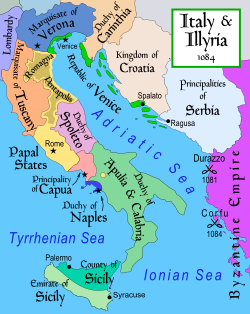County of Apulia
| County of Apulia and Calabria | ||||||||||||||
| Contea di Puglia e Calabria | ||||||||||||||
| Vassal state of the Papacy | ||||||||||||||
|
||||||||||||||
|
Motto Servire Nescit |
||||||||||||||
|
The Duchy in the political context of Italy and the Balkans in 1084.
|
||||||||||||||
| Capital |
Melfi (1043–1077) Salerno (1077–1130) |
|||||||||||||
| Languages | Norman, Neapolitan-Sicilian, Greek (minority) | |||||||||||||
| Religion | Roman Catholicism | |||||||||||||
| Demonym | Normans (generally), Apulians, Calabrians | |||||||||||||
| Government | Feudal absolute monarchy | |||||||||||||
| Count/Duke | ||||||||||||||
| • | 1043–1046 | William I | ||||||||||||
| • | 1059–1085 | Robert I | ||||||||||||
| • | 1111–1127 | William II | ||||||||||||
| Historical era | Middle Ages | |||||||||||||
| • | Lombard lords elect William of Hauteville as Count | 1043 | ||||||||||||
| • | Norman conquest of Salerno | 1076 | ||||||||||||
| • | Emperor Henry III recognize the County | 1047 | ||||||||||||
| • | Battle of Civitate; Pope Leo IX recognize the County | 1053 | ||||||||||||
| • | Treaty of Melfi; the County become Duchy | 1059 | ||||||||||||
| • | Death of the childless William II | 1127 | ||||||||||||
| • | Coronation of Roger; Duchy annexed to Sicily | 1130 | ||||||||||||
| Currency | Follis (common) | |||||||||||||
|
||||||||||||||
| Today part of |
|
|||||||||||||
The County of Apulia and Calabria, later the Duchy of Apulia and Calabria, was a Norman country founded by William of Hauteville in 1042 in the territories of Gargano, Capitanata, Apulia, Campania, and Vulture. It became a duchy when Robert Guiscard was raised to the rank of duke by Pope Nicholas II in 1059.
The duchy was disestablished in 1130 when the last duke of Apulia and Calabria, Roger II of Sicily became King of Sicily. The title of duke was thereafter used intermittently as a title for the heir apparent to the Kingdom of Sicily.
William I of Hauteville, who returned in September 1042 in Melfi, was recognized by all the Normans as supreme leader. He turned to Guaimar IV, Lombard, Prince of Salerno, and Rainulf Drengot, Count of Aversa, and offered both an alliance. With the unification of the two Norman families, Altavilla and Drengot, Guaimar offered official recognition of the conquests and at the end of the year, an assembly of Lombards and Norman barons at Melfi met with Rainulf and William, which ended at the beginning of the following year (1043). In this meeting, Guaimar V of Salerno ensured the Hauteville dominance over Melfi. William of Hauteville formed the second core of his possessions and differentiated himself from Rainulf I of Aversa, head of the territories of Campania. All the barons present offered a tribute as a vassal to Guaimar, which recognized William I of Hauteville as the first of the title of Count of Apulia. To tie it to himself, he offered to marry her niece Guide, daughter of Guy, Duke of Sorrento. Guaimar reconfirmed the title of count to Rainulf as well, which created the County of Puglia.
...
Wikipedia


